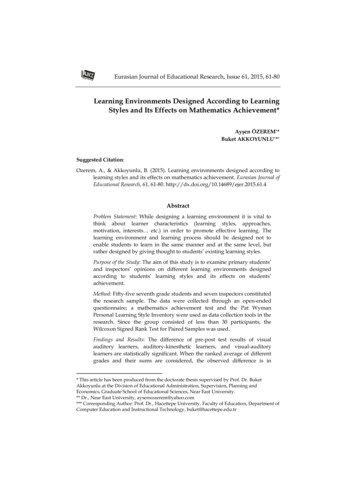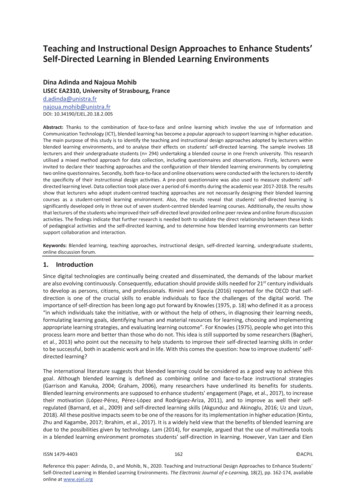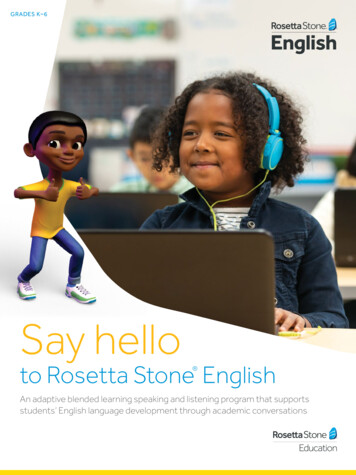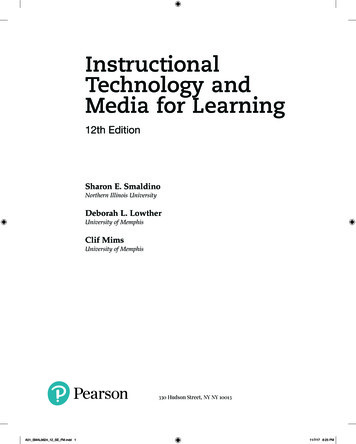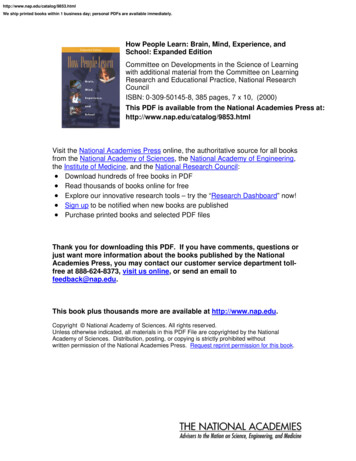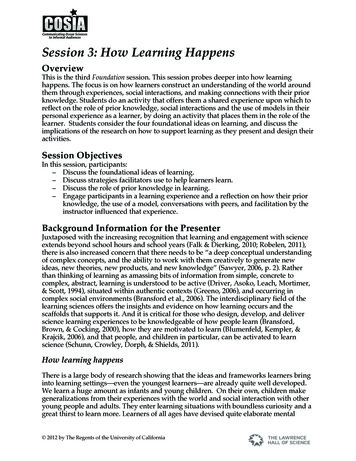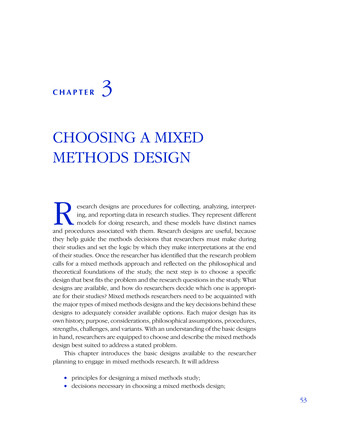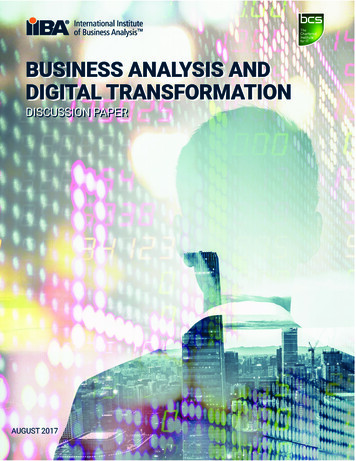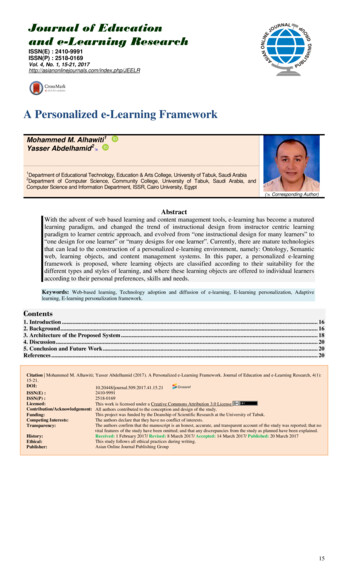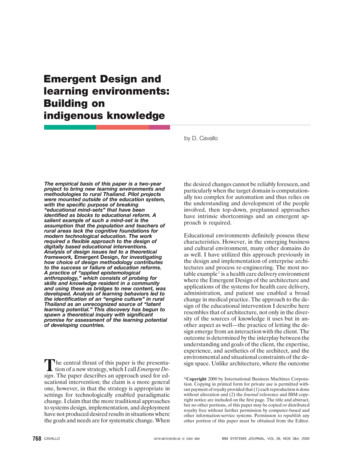
Transcription
Emergent Design andlearning environments:Building onindigenous knowledgeby D. CavalloThe empirical basis of this paper is a two-yearproject to bring new learning environments andmethodologies to rural Thailand. Pilot projectswere mounted outside of the education system,with the specific purpose of breaking“educational mind-sets” that have beenidentified as blocks to educational reform. Asalient example of such a mind-set is theassumption that the population and teachers ofrural areas lack the cognitive foundations formodern technological education. The workrequired a flexible approach to the design ofdigitally based educational interventions.Analysis of design issues led to a theoreticalframework, Emergent Design, for investigatinghow choice of design methodology contributesto the success or failure of education reforms.A practice of “applied epistemologicalanthropology,” which consists of probing forskills and knowledge resident in a communityand using these as bridges to new content, wasdeveloped. Analysis of learning behaviors led tothe identification of an “engine culture” in ruralThailand as an unrecognized source of “latentlearning potential.” This discovery has begun tospawn a theoretical inquiry with significantpromise for assessment of the learning potentialof developing countries.The central thrust of this paper is the presentation of a new strategy, which I call Emergent Design. The paper describes an approach used for educational intervention; the claim is a more generalone, however, in that the strategy is appropriate insettings for technologically enabled paradigmaticchange. I claim that the more traditional approachesto systems design, implementation, and deploymenthave not produced desired results in situations wherethe goals and needs are for systematic change. When768CAVALLOthe desired changes cannot be reliably foreseen, andparticularly when the target domain is computationally too complex for automation and thus relies onthe understanding and development of the peopleinvolved, then top-down, preplanned approacheshave intrinsic shortcomings and an emergent approach is required.Educational environments definitely possess thesecharacteristics. However, in the emerging businessand cultural environment, many other domains doas well. I have utilized this approach previously inthe design and implementation of enterprise architectures and process re-engineering. The most notable example 1 is a health care delivery environmentwhere the Emergent Design of the architecture andapplications of the systems for health care delivery,administration, and patient use enabled a broadchange in medical practice. The approach to the design of the educational intervention I describe hereresembles that of architecture, not only in the diversity of the sources of knowledge it uses but in another aspect as well—the practice of letting the design emerge from an interaction with the client. Theoutcome is determined by the interplay between theunderstanding and goals of the client, the expertise,experience, and aesthetics of the architect, and theenvironmental and situational constraints of the design space. Unlike architecture, where the outcome娀Copyright 2000 by International Business Machines Corporation. Copying in printed form for private use is permitted without payment of royalty provided that (1) each reproduction is donewithout alteration and (2) the Journal reference and IBM copyright notice are included on the first page. The title and abstract,but no other portions, of this paper may be copied or distributedroyalty free without further permission by computer-based andother information-service systems. Permission to republish anyother portion of this paper must be obtained from the Editor.0018-8670/00/ 5.00 2000 IBMIBM SYSTEMS JOURNAL, VOL 39, NOS 3&4, 2000
is complete with the artifact, the design of educational interventions is strengthened when it is applied iteratively. The basis for action and outcomeis through the construction of understanding by theparticipants.The technological ramifications are immense. We often build inappropriate technology because the domain changes too quickly, or the designers’ understandings and aesthetics vary too much from theusers’ understandings, needs, and goals. At othertimes projects fail because, even though the technology might be appropriate, the deployment isflawed. Design cycles that cannot adapt to rapidlychanging conditions miss emergent phenomena thateither need correction because they are undesirable,or need capitalization if desirable. A resultant longterm problem is lack of belief in the true possibilities for technology because it did not live up to expectations. This is certainly the case in education,although business uses also share this outlook, as evidenced by complaints about lack of productivitygains through technology.Perhaps more importantly, traditional approachesto learning of and through technology have not mobilized the indigenous knowledge and expertiseamong many people. The growing “digital divide”—concerns about the potential of a widening gap between rich and poor in the new, knowledge-basedglobal economy due to a lack of modern, technological skills among people in lower social-economicstrata, and a growing concern about the potential ofeducational systems to ameliorate this situation—all point to a serious problem becoming seeminglypermanently intractable.This paper describes an approach to technology design and use that provides hope for a different, morepositive outcome. The same technology that can bea primary factor in widening the divide, may be thebest hope for eliminating the divide. The EmergentDesign approach enabled the discovery and utilization of latent, engineering expertise and creativityamong people in rural Thailand. Rather than beingbereft of social capital necessary to succeed in thenew economy, these traditionally poor, rural peopleare conceivably better situated for success so long asthe technology and methodology used is expressive, appropriable, and constructionist.While the claims here are broad, I choose to focuson one concrete example, that of an effort in educational reform. Educational institutions, althoughIBM SYSTEMS JOURNAL, VOL 39, NOS 3&4, 2000relatively young, have proven extremely resistant tochange. 2 Moreover, schools for the most part havenot used new computational technology in innovative ways. This, despite a lot of hype for the possibilities of technology in education, has caused manyto doubt the potential in the technology. The problem, though, is not with the technology per se, butrather with the design, deployment, and uses of thetechnology.Technology and the reform of educationalenvironmentsEducational reform efforts, over a long period oftime, have offered many different blueprints. Yetnone has had the substantial effect for which it wasdesigned. Why is this the case?We need to look at the way in which education reforms are usually carried out. Some set of individuals decide there is a problem needing addressing(such as low math and science scores) or a changedeserving implementation (such as the introductionof a new item like ethics to the curriculum). A groupconvenes. They call in the various experts, stakeholders, practitioners, and other usual suspects. They design a blueprint for their reform. The blueprint contains a curriculum, materials, texts, assessment,teacher training, and so on.This paper presents the view that these blueprintshave failed simply because they are blueprints. Manyanalysts researching this situation, most recentlyDavid Tyack and Larry Cuban, 2 have shown how theprocess fails. Whatever blueprint is proposed, it isinevitably going to be transformed in the course ofappropriation, ending more in conformance withwhat the designers originally hoped to reform. Theinstitution tends to reform the reform, perhaps retaining the rhetoric but rendering it toothless. Tyack and Cuban brilliantly term 3 the overriding mindset the “grammar of school.” Like a grammar, theydescribe a deeply held organizing system that allowsonly certain expressions (or actions) as legitimate andrenders some expressions nonsensical if they deviate from the underlying system.Tyack and Cuban made clear that whether reformsare big or small, from the “right” or from the “left,”national or local in scope, they do not work. Somemight deserve to fail because of the nature of theircontent. But while content may or may not be a limiting factor, they fail because of the form in whichthey were designed.CAVALLO769
What is needed is an alternative approach that is nota blueprint. This naturally raises the question ofwhether having no blueprint means the abrogationof all design and planning so that “anything goes.”In the same way that a jazz group can improvisewithin the structure of a piece while remaining coordinated and within the theoretical principles of thegenre, so too can an emergent design remain consistent within a core set of principles. 4This paper describes a form of intervention in learning that is very different from the model of reformstudied by Tyack and Cuban. It offers hope for addressing the great educational needs created by thedigital age by drawing on two of its important innovations: (1) digital technology and (2) the approachto management of organization and of organizationalchange that has come in the wake of the technology.More precisely, this work draws on the combinationof these two innovations. A distinction must be madebecause, as I show, the temptation to use either ofthem alone has led to failure. It is the combinationthat offers an optimistic vision for the future of learning—the combination of these two products of thedigital age along with a theoretical framework basedon the work of pre-digital-age thinkers who knewwhat to do but did not have the means to do it.Among these the most central is Paulo Freire, 5 butalso represented are John Dewey 6 and, although hedid not focus on education per se, Jean Piaget. 7Limitations of a single focus. A focus solely on technology leads to technocentrism, that is, a view thatit is the technology and not what we do with it thathas impact. 8 Such a focus also leads to a narrownessof vision. In other words, we simply place the technology into the existing structure and thus are notable to see the possibilities that extend beyond theexisting organization. Merely adding technology reinforces an experimental paradigm out of place. Thisparadigm tries to modify one element at a time, holding the others constant. When using such an approach when introducing technology, what one holdsconstant—rather than maintaining experimental purity—merely serves to neuter the potential for educational change catalyzed by the technology. Thus,an erroneous view of the technological and learningpotential results.In his book The Productive Edge, 9 Richard Lesterdescribes mistakes made within conventional mindsets about business, productivity, and change that resonate with conventional mind-sets of education and770CAVALLOschool reform. Lester describes how many companies, in an attempt to improve productivity, quality,or some other often highly quantifiable attribute,would attempt to apply a seemingly scientific methodby researching a new methodology or so-called bestpractice; they then attempted to test whether adding this method to their own operation would gen-Adoption and implementationof new methodologies needsto be based in,and grow from,the existing culture.erate positive results, holding all other things constant. In a vast majority of cases such applicationsof new methods failed to produce positive results.This not only called into question whether the newmethodologies truly had value, but also led to an experimental fatigue from being repeatedly forced toadapt to the change program of the month.What Lester demonstrated was that there are nottypically such things as decontextualized best practices that can be grafted onto existing organizationsand thereby produce results. Rather, each companyhas its own complex culture, full of subtleties, andsuccessful companies are the ones that can innovate,cultivate, adapt, and use methods that can thrive intheir particular environment. The successful approaches fit more with the Emergent Design concept advocated here than with the more traditionaltop-down, change-one-variable-at-a-time approachesthought to be more in the line of scientific management. Digital technology enabled the customizationof process to culture rather than forcing culture tobe responsive to management dictates and “the onebest method.” 10 The critical point is that adoptionand implementation of new methodologies needs tobe based in, and grow from, the existing culture, andtypically fails when it is merely imposed from abovewithout such cultural considerations. Interestingly,incremental approaches to educational reformclosely resemble the less successful methods thatLester describes.The reform of educational management, usually inthe form of administrative decentralization, does notIBM SYSTEMS JOURNAL, VOL 39, NOS 3&4, 2000
break the stranglehold of the grammar and ends upwith reversion to type. By themselves, ideas such asdecentralization of control and decision-making, orintradistrict competition, do not generate new content and methods. On the contrary, they merely pushthe same practices down the hierarchy without fundamentally changing practice. Thus, the only substantial change is in administration, not innovationin the learning environment.The need for new principles. Saying one needs tobase new methodologies and the change process toresonate with, and build upon, existing culture doesnot mean that deep change is not intended, nor thatany type of change is desired. In the case of learningenvironments, the primary principles we broughtwere: constructionism, technological fluency, immersive environments, long-term projects, applied epistemological anthropology, critical inquiry, and Emergent Design.Constructionism builds 11–13 upon principles in constructivism. While constructivism holds that thelearner constructs new knowledge based on the existing knowledge he or she has, constructionismbuilds on this idea by maintaining that this processhappens particularly well when the learner is in theprocess of constructing something. For example, inour work with LEGO**-Logo 14,15 we witnessed manychildren, including those who had previously doneextremely poorly in school, understand complex ideasin mechanics, physics, and mathematics through constructing LEGO robots to accomplish various tasks.The idea of building technological fluency draws onthe image of being fluent in a language. 16,17 Whenone is fluent in a natural language one can think,express, communicate, imagine, and create with thatlanguage. In the same way, we like to develop fluency through the construction of, and with technology as a means of, personal and group expression.We try to develop fluency with technology in orderto help people become more eloquent and effectivein their expression. Just as fluency changes the focus to a more holistic use of natural language, thisalso changes the focus of learning with technology.Just as the idea of fluency is adopted from language,so too is the concept of immersive environments. Being immersed in the culture and environment facilitates learning a foreign language. So too does working with others in a culture where the knowledge oftechnology and construction is deeply embedded facilitate the development of technological fluency.IBM SYSTEMS JOURNAL, VOL 39, NOS 3&4, 2000Building artifacts of interest to learners aids the construction and the development of fluency. In orderto delve deeply enough to unearth the underlyingconcepts and principles, we enable students to workon projects over a long period of time. Rather thanrushing through a broad curriculum in a shallowmanner, we prefer to encourage diving deeply intothe projects. This takes time. This also differentiatesour practice from other project-oriented approachesin education, where the project is preplanned by thecurriculum designers and not emergent from the interests of the learners, and where it lasts only a shortperiod of time in order to fit the traditional classroom situation.Applied epistemological anthropology is a term I havegiven to the practice of unearthing the meaninglearners attribute. This applies on both a cultural andindividual basis. In order to facilitate the construction of new knowledge on the existing knowledge ofthe learners, one must first help discover the existing frameworks as best one can. This practice itselfis facilitated through the construction of objects ofinterest to the learner, where the learner has as muchfreedom of expression as possible. When the freedom of expression exists, then the learner has thespace in which to express himself or herself in a manner faithful to the learner’s thoughts. This is a keyelement in the design of technologies for learning.Through the construction, and mediated by discussion, the underlying thoughts become more evident.This enables the teacher or facilitator to better design and implement learning interactions. This leadsto the necessity of a more emergent approach.Critical inquiry is the process of engaging in a conversation with one’s world in order to understandand act upon it. 5 Through critical inquiry we collaboratively determine upon which projects to work. Alsothrough critical inquiry we try to understand the phenomena of study in sufficient detail so as to constructartifacts modeling the phenomena or designed toameliorate the situation, as well as to understand anddebug the artifacts of construction.Emergent Design is what manages the overall process. Due to the emphasis on approaching learningby building on the existing knowledge of the learners through their expressive construction of projectsof their own choosing, this process by definition hasstrong emergent tendencies. However, design is alsoemphasized as the others in the community who workwith learners— be they teachers, parents, or othercommunity members—also play an active role in asCAVALLO771
sisting to assist and guide the learner in the process.The idea of design extended to a “grassroots” levelenters because, just as Emergent Design is practicedto facilitate organizational change, so too is Emergent Design practiced in the interaction betweenteachers and learners.There is no claim that the methodology describedin this paper is the only way to achieve the desiredresults. What this does serve as is an existence proofof a way. That this way at least initially demonstratesinteresting, unexpected, and quite positive resultsamong populations that previously did not exhibitsuch results in traditional settings should serve toquestion the existing school grammar as well as tofacilitate other such experiments. I close this sectionwith a story that illustrates the prevailing educationalmind-set as well as effective informal methods thatcan be leveraged.DOS commands and flower gardens. On my first visitto Thailand my hosts took me to a nonformal education (NFE) site in a Buddhist temple. I saw a computer class held at the NFE temple school. A childwas being taught DOS commands. The logic behindsuch an introduction to computers, following the typical school curriculum grammar of using sequentialbuilding blocks of knowledge, is that it provides therequisite basis for later, more difficult learning. However, the useful learning never comes! And in themeantime, the formalistic nature of the beginningwork confuses and frustrates the novice.The student’s teacher assigned four commands forhim to learn and practice. The first was dir, to geta listing of files in his directory. The second was copy,to copy a file from one location to another. The thirdwas format, to format his A drive (fortunately, it wasnot the C drive). I do not remember the fourth butit was made irrelevant by the reformatting of his disk.This confounding situation led the student to stopme with a plaintive question, “What is the problemhere? It worked before but now it no longer works.I am following my teacher’s instructions, but this isnot working properly.” On the first iteration of practicing his commands by rote, everything was fine.Subsequently, however, none of the commands wasgiving the specified results. His directory was nowempty. He could not copy his file. I explained to himthat the result of using the format command is thatit reformats the entire disk, meaning it wipes cleanwhat was on it and sets it for the computer’s oper772CAVALLOating system. Thus, there were no more files in hisdirectory to list or to copy.Despite several attempts at various ways of explaining it, including recreating the example on the computer and showing how dir, copy, and format workwith a newly created set of files, I am not sure heunderstood my explanations. One reason for this isI suggested that we createenvironments for learningcomputational ideasin the same mannerthat monks learn gardening.that my explanations meant that what his teacher hadsaid, done, and assigned no longer made sense, whichwould be quite disorienting. Another possibility isthat no matter what the explanations and examples,learning commands this way is too decontextualizedto make sense. One is merely learning by rote whatsomeone else says is important without any conception of why or how it might be used.The split between conventional “School thinking” 18and cultural learning was shown vividly in the contrast between the computer class at the temple andhow the monks themselves teach flower gardening.Beautiful flowers are grown and displayed at all theBuddhist temples in Thailand. They are impressive,colorful, and fragrant. After my visit and the experience with DOS teaching run amok, I inquired abouthow people learned to cultivate such gorgeous gardens. A monk explained that when initiate monksenter the temple, they work alongside more experienced ones and learn by demonstration, by askingquestions, in the best sense of learning by doing. Imischievously asked whether any classroom instruction was involved. The monk looked at me askance,but politely answered no, they felt there was no need.I tried to explain that this was the approach we alsopreferred for learning computational ideas. That is,that new learners work on projects of their own, arein an environment with others working on similar,but perhaps more complex, projects, and can observeand ask others questions—in essence they are immersed in a culture of computing just as the monksare immersed in their culture.IBM SYSTEMS JOURNAL, VOL 39, NOS 3&4, 2000
The depth of resistance to these ideas was illustratedby the way the teacher who was translating my remarks into Thai misrepresented the explanation, creating an initial misunderstanding between the monkand me. After listening to my translator, the monkpolitely responded that they would never do what Isuggested. Considering that I had just suggested thatwe create environments for learning computationalideas in the same manner that the monks learn gardening, I could not understand how he disagreed.So I inquired again about what was said. The teachertold me that she told the monk I had suggested thatthey teach gardening in a classroom just as we teachcomputers in a classroom. When I re-explained whatI had really intended, the teacher could not believeI meant it. Rather than immediately retranslating,she passionately protested. Surely classrooms werethe modern and most effective means of teaching.How could I, from a modern western university, suggest that the monk’s method could be better? It tookquite a while to get her to tell the monk what Ithought. In retrospect, this was a powerful learningmoment for my translator, although thoroughly andnecessarily unplanned.Scenes from Project LighthouseThe context of this paper is Project Lighthouse, abold intervention to initiate radical change in the educational processes in Thailand. As its name suggests,Project Lighthouse is not a blueprint for educationor education reform. Rather, it attempts to highlightactual possibilities for powerful learning environments in Thailand, particularly in settings where traditional education has not succeeded. A primary goalis to break mind-sets about what education must beby providing concrete examples. The following aresamples of activities from Project Lighthouse overa 17-month period. The scenes provide a concretebasis for the discussion that follows.Bangkok, March 1997. In the first scene, SeymourPapert and I, from the MIT Media Lab, were meeting with leaders of the Suksapattana Foundation. 19We were designing a proposed intervention intendedto provoke a radical reform of the educational system in Thailand. The meeting came about becausea group of industry leaders and government officialshad come to believe that, unless they achieved a total transformation of their educational system, Thailand would not merely stagnate economically, butalso that they would lose all the gains of the previous decade. More critically, the leaders worried thatthere was a growing and more intractable divide beIBM SYSTEMS JOURNAL, VOL 39, NOS 3&4, 2000tween rich and poor that would destroy the fabricof Thai society. They further believed that in the absence of an educated, thoughtful, literate populace,it would be impossible to support their nascent democracy and prevent a return to autocratic, and corrupt, military rule.The Thai leaders believed that the existing schoolwas not a hospitable medium for developing alternative forms of learning. Moreover, they felt that tochange it directly would cost too much and take toolong. They believed the existing schools to be toorigid, too reliant on rote instruction, and staffed bytoo many teachers who were barely educated themselves.They had set bold and ambitious goals for their educational system. They had developed a new nationaleducation plan as an essential part of their nationaldevelopment plan. This education plan, combinedwith a special commission from the Office of thePrime Minister devoted to education reform (ONEC),specified the new goals. 20 The goals were thoughtful and admirable. They included: Becoming learner-centeredDeveloping critical-thinking abilityFostering innovation and creativityDeveloping collaborative spirit and skillsLearning how to learnProviding familiarity, ability, and comfort in working with technologyDeveloping “happy” learning, that is, a joy forlearningHowever, none of the plans specified how to achievesuch a system. They did not discuss how to operatein this new paradigm or how to make the transformation. Thus, while the goals were lofty, the implementation of both the new system and the methodof reforming the current one, were mired in the existing, undesirable paradigm.The goal behind our endeavor, Project Lighthouse,was to break mind-sets by creating technologicallyrich learning environments that would demonstratethe “out-of-the-box,” yet practical, possibilities forchildren in Thailand.However, it was not clear what to do. Moreover,there was little agreement on, or acceptance of, ourproposal. Some believed that we should focus ongaining the acceptance of the national curriculumdevelopers as the current system moved only throughCAVALLO773
the curriculum. Others believed we from MIT shouldtrain the trainers who would then train the teacherswho would then work with the students. Others feltwe should place computer labs in more schools andtrain teachers to work there. Finally, there was nearunanimous agreement that the existing teacher corpswas incapable of working in a new, learner-centered,project-based, technologically rich environment. Virtually everyone told us that the teachers were barelyeducated themselves and might not be able to learnto use the technology, let alone teach with it.We proposed creating four pilot projects where wecould quickly demonstrate significant results in someof the most critical areas of need. 21 These were: Alternative learning environments within nonformal educationRural village learning centersTeacher developmentAlternative learning environments for at-risk youthsuch as street children in urban areas and girls atrisk for or exiting prostitutionThere were two major objections to our proposal.First, commentators argued that our proposal didnot fit the prototype five-year plan, which spells outall activities over that time period. How could people know what to do if we did not provide such aplan? People wondered if perhaps either we werenot serious or did not know what we were doing. Second, people told us that the quality of the teachercorps was so low that they would be incapable of carrying out an ambitious endeavor such as ours.774is needed is a philosophy of design for educationalinnovation as different from traditional ideas of reform as the content of the new innovation would befrom traditional educational content. The theoretical framework that evolved from this and similarexperiences of Project Lighthouse is Emergent Design.The phrase Emergent Design puts a spotlight on theneed (which has not been recognized by educationpolicymakers) to study the conceptual space wherethe purposeful stance implied by the word “design”mates with the openness implied by the word “emergent.” This mating underlies modern approaches toorganizational practice.The emphasis on emergence as the guiding principledoes not imply that this is an anything-goes environment reacting to the whims of the participant teachers and learners. As described above, we brought avery disciplined set of principles, methodologies,tools, activities, models, and exemplars for learningenvironments. However, to deliver a pre-set curriculum with pre-chosen problems, explanations, andsequence of events would be not only antithetical tothe underlying learning philosophy, but also it wouldbe inca
Emergent Design and learning environments: Building on indigenous knowledge. is complete with the artifact, the design of educa-tional interventions is strengthened when it is ap-plied iteratively. The basis for action and ou

